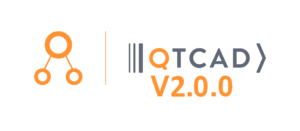A new version of QTCAD® has just been released!

We are very happy to release a new version of QTCAD®, which includes major new features and improvements to key solvers and new modules marking a significant expansion of our software.
As listed below, the focus in this release of QTCAD® 2.0, as the versioning indicates it, is the addition of exclusive content with 2 new modules and interesting improvements for our current users to the semiconductor spin-qubit module. Interestingly, the number of lines of code and the scope of QTCAD® has truly doubled since the first version (v1.0) released in May 2022.
Main updates and new features in this version 2.0.0 are the following:
- NEW! Introduction of the QTCAD® Atoms package for multiscale simulations of
quantum dots (QDs) using the atomistic tight-binding (TB) method.
QTCAD® Atoms includes:- A builder to model the atomic structure of QDs which includes realistic
nonidealities such as strain, random alloying, and surface roughness using
a random rough surface generator. - An electronic structure solver based on the TB model and a sparse
This solver captures magnetic fields, spin-orbit coupling and
the effect of strain at the atomic scale. - The builder and electronic structure solver support Si, Ge, and SiO2
materials, in addition to SiGe alloys with arbitrary composition. - Various analysis tools such as atomistic wavefunction visualizers,
matrix-element calculators, and g-tensor calculators. - Interfaces to QTCAD®’s FEM modeling capabilities, such as the inclusion
of a gate-induced confinement potential computed within the FEM into the
TB Hamiltonian produced by QTCAD® Atoms, thereby enabling multiscale - Tutorials highlighting the various features of QTCAD® Atoms and their
proper usage. These tutorials cover multiscale modeling of Si/SiGe and
FD-SOI quantum dots, valley physics, quantum control, and g-tensor
- A builder to model the atomic structure of QDs which includes realistic
- NEW! Introduction of superconducting circuit modeling features:
- A capacitance matrix solver based on an adaptive-mesh linear Poisson
This adaptive-mesh solver is optimized to handle numerical
challenges that typically arise when modeling superconducting circuits,
such as sharp corners and embedded 2D surfaces. - A frequency-domain finite-element Maxwell solver that may be used to
compute the eigenmodes of superconducting resonators and cavities. - Tutorials for capacitance matrix and Maxwell eigenmode calculations.
- A tutorial for usage of QTCAD® as a Qiskit Metal renderer.
- A capacitance matrix solver based on an adaptive-mesh linear Poisson
- Improvements to finite-element spin-qubit modeling:
- Periodic boundary conditions for the linear and non-linear Poisson
- A new tutorial applying periodic boundary conditions to describe
shuttling in a FD-SOI quantum dot structure. - The capability to implement a mirrored mesh.
- Added support to the Friesen model in the Multi-Valley Effective-Mass
Theory (MVEMT) solver, which complements the previously-available
Shindo-Nara model. - Updated several dependency versions (e.g., Python, MKL, NumPy, SciPy).
- Added support for “.vtm“ files to enable visualization of more complex
datasets in ParaView. Using “.vtm“ files, it is possible to break down
visualization into device regions. - Added the possibility to specify the maximal characteristic length in
certain regions of a device when using the adaptive-mesh linear Poisson - More transparent error messages.
- The following API changes were made that are not backward compatible
with versions prior to 2.0:- Dropped support for brute-force Coulomb integrals calculations. This
legacy method was the only supported method until version 1.5, in which
Coulomb integrals filtering method were introduced. In version 1.5, the
initial method became known as the “”basic”“ filtering method, while
the new technique was called “”extensive”“ filtering. Starting from
version 2.0, “”basic”“ filtering is not supported anymore. - Dropped direct imports of “device“, “qubit“, and “transport“
modules which were deprecated but still allowed with a warning until
version 1.5.2. It is now mandatory to import “qtcad.device“,
“qtcad.qubit“, and “qtcad.transport“ modules instead.
- Dropped support for brute-force Coulomb integrals calculations. This
As it is now a tradition which is gladly and duly observed at each release, we want to thank very much for their trust all our active users and partners.
We sincerely appreciate the increasing number and quality of our users, from both academic and industrial organizations. Some of our QTCAD® partners have been utilizing our software for nearly 3 years, and we greatly value their invaluable feedback. We extend a special thank you to them for helping us develop a reliable, powerful, and unique software solution in the market.
To join the QTCAD® community, simply create your user account on our portal and download the tool to test it: https://portal.nanoacademic.com/ It’s fast and easy.
The online documentation has been updated, you will find all the information on this new version here: QTCAD 2.0 — QTCAD 2.0 documentation (nanoacademic.com).
Link to the latest QTCAD® brochure: PLEASE CLICK HERE
Also, do not miss checking out on QTCAD® EDU, a version of QTCAD® to teach students in classroom: More information here.
Please follow us on LinkedIn and on X!
Thank you very much for your interest and continued support.
Nanoacademic’s Quantum Technology team in charge of QTCAD®.













